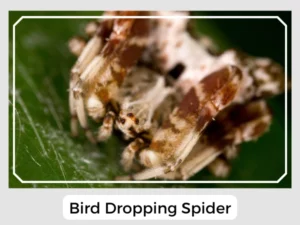The Bird-dropping spider from Australia is a part of the orb-weaver family. Why such a funny name? Because they look just like a bird’s dropping! They’re big and have colors that trick others into thinking they’re just a bird’s mess. There are other spiders, like the ones in the Mastophora group, that look like this too.
The females produce about 13 egg sacs with each containing 200 eggs on average. The egg sacs look like marble-shaped brown balls, having a diameter of 0.47 inches (12 mm), held together with strong thread-like structures.
The spiderlings emerging from the sacs have a pale color at the beginning that darkens as they mature.
Only the young bird-dropping spider makes circular webs. The females do not spin webs and have a different strategy of capturing their prey. They hang from a leaf upside down, waiting for the moth to come, and the moment it does, they seize it with their sturdy legs.
Yes, Bird-dropping spiders have venom. They use it to catch their food. But for humans, it’s not very strong.
They can bite if they feel bothered. It might feel like a little pinch, but most people don’t find it too bothersome.
The Bird-dropping Spider plays a vital role in controlling moth populations within its habitat. Its unique mimicry and behavior allow it to capture its prey efficiently, contributing to the balance of the ecosystem. It releases pheromones that imitate the female moth’s scent, luring in male moths and demonstrating a fascinating predator-prey dynamic.
Natural Predators and Prey-Predator Dynamics: Despite its clever disguise, the Bird-dropping Spider is not without natural threats. Birds and wasps are common predators, though the spider’s appearance and behavior significantly reduce the risk of predation.
Relationship with Humans: Humans typically find this spider in forests, wetlands, woodlands, and even in orchards and gardens. Its presence is generally beneficial as it helps control moth populations. The spider’s unique appearance and behavior also make it a subject of interest, contributing to biodiversity awareness and education.
| Other Names | Orchard Spider, Death’s Head Spider, |
| Distribution | Eastern, southern, and central parts of Australia |
| Habitat | Forests, wetlands, heath, woodlands, as well as orchards and gardens (sitting on fruit trees) |
| Predators | Birds and wasps |
| Diet | Insects, mainly moths |
| Lifespan | 1 year |

In summary, the Bird-dropping Spider is a remarkable example of nature’s ingenuity. Its ability to mimic bird droppings to evade predators and attract prey is a testament to the complexity and beauty of evolutionary adaptations.
The Bird-dropping spider from Australia is a part of the orb-weaver family. Why such a funny name? Because they look just like a bird’s dropping! They’re big and have colors that trick others into thinking they’re just a bird’s mess. There are other spiders, like the ones in the Mastophora group, that look like this too.
The females produce about 13 egg sacs with each containing 200 eggs on average. The egg sacs look like marble-shaped brown balls, having a diameter of 0.47 inches (12 mm), held together with strong thread-like structures.
The spiderlings emerging from the sacs have a pale color at the beginning that darkens as they mature.
Only the young bird-dropping spider makes circular webs. The females do not spin webs and have a different strategy of capturing their prey. They hang from a leaf upside down, waiting for the moth to come, and the moment it does, they seize it with their sturdy legs.
Yes, Bird-dropping spiders have venom. They use it to catch their food. But for humans, it’s not very strong.
They can bite if they feel bothered. It might feel like a little pinch, but most people don’t find it too bothersome.
The Bird-dropping Spider plays a vital role in controlling moth populations within its habitat. Its unique mimicry and behavior allow it to capture its prey efficiently, contributing to the balance of the ecosystem. It releases pheromones that imitate the female moth’s scent, luring in male moths and demonstrating a fascinating predator-prey dynamic.
Natural Predators and Prey-Predator Dynamics: Despite its clever disguise, the Bird-dropping Spider is not without natural threats. Birds and wasps are common predators, though the spider’s appearance and behavior significantly reduce the risk of predation.
Relationship with Humans: Humans typically find this spider in forests, wetlands, woodlands, and even in orchards and gardens. Its presence is generally beneficial as it helps control moth populations. The spider’s unique appearance and behavior also make it a subject of interest, contributing to biodiversity awareness and education.
| Other Names | Orchard Spider, Death’s Head Spider, |
| Distribution | Eastern, southern, and central parts of Australia |
| Habitat | Forests, wetlands, heath, woodlands, as well as orchards and gardens (sitting on fruit trees) |
| Predators | Birds and wasps |
| Diet | Insects, mainly moths |
| Lifespan | 1 year |

In summary, the Bird-dropping Spider is a remarkable example of nature’s ingenuity. Its ability to mimic bird droppings to evade predators and attract prey is a testament to the complexity and beauty of evolutionary adaptations.